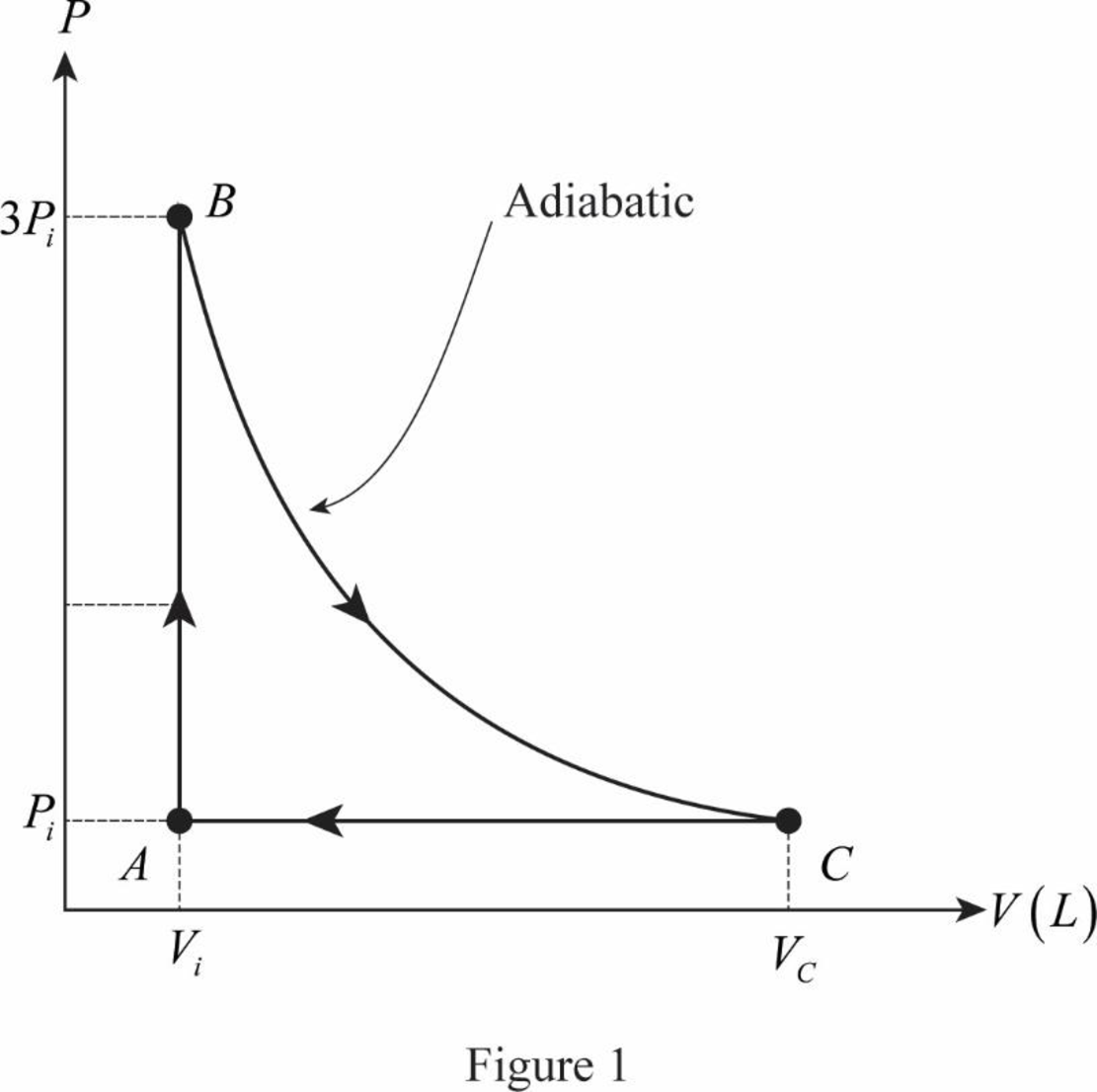
(a)
Draw the PV diagram of the closed cycle.
(a)
Answer to Problem 34P
The PV diagram for the closed cycle is drawn.
Explanation of Solution
An adiabatic process occurs without
An Isobaric process is a thermodynamic process in which the pressure stays constant. The heat transferred to the system does work, but also changes the internal energy of the system.
Conclusion:
The figure 1 shows the PV diagram for the ideal gas expands adiabatically to its original pressure and compressed isobarically to its original volume.

(b)
The volume of the gas at the end of the adiabatic expansion.
(b)
Answer to Problem 34P
The volume of the gas at the end of the adiabatic expansion is
Explanation of Solution
Write the expression from PV diagram at the point B and C.
Here,
Conclusion:
Rewrite the above expression from the PV diagram to find volume.
Here,
Therefore, the volume of the gas at the end of the adiabatic expansion is
(c)
The temperature of the gas in an adiabatic expansion.
(c)
Answer to Problem 34P
The temperature of the gas in an adiabatic expansion is
Explanation of Solution
Write the expression from
Here,
Write the expression from the PV diagram
Here,
Conclusion:
Compare equation (II) and (III) to find
Therefore, the temperature of the gas in an adiabatic expansion is
(d)
The temperature at the end of the cycle.
(d)
Answer to Problem 34P
The temperature at the end of the cycle is
Explanation of Solution
Write the expression for temperature for whole cycle.
Here,
Conclusion:
Therefore, the temperature at the end of the cycle is
(e)
The net work done on the gas.
(e)
Answer to Problem 34P
The net work done on the gas is
Explanation of Solution
Write the expression for energy transfer between the points AB.
Here,
Replace
Write the expression for energy transfer for adiabatic process between the points BC.
Write the expression from ideal gas law.
Here,
Replace
Write the expression for energy transfer between the points CA.
Here,
Replace
Conclusion:
Find the energy transfer for whole cycle.
Substitute the equation (V), (VI) and (VII) in above equation.
Rewrite the above equation.
Find the internal energy for whole cycle.
Here,
Substitute equation (VIII) in the above equation.
Therefore, the net work done on the gas is
Want to see more full solutions like this?
Chapter 21 Solutions
Bundle: Physics for Scientists and Engineers with Modern Physics, Loose-leaf Version, 9th + WebAssign Printed Access Card, Multi-Term
- No chatgpt plsarrow_forwardhelp me with the experimental set up for the excel i did. the grapharrow_forwardWhich of the following best describes how to calculate the average acceleration of any object? Average acceleration is always halfway between the initial acceleration of an object and its final acceleration. Average acceleration is always equal to the change in velocity of an object divided by the time interval. Average acceleration is always equal to the displacement of an object divided by the time interval. Average acceleration is always equal to the change in speed of an object divided by the time interval.arrow_forward
- The figure shows the velocity versus time graph for a car driving on a straight road. Which of the following best describes the acceleration of the car? v (m/s) t(s) The acceleration of the car is negative and decreasing. The acceleration of the car is constant. The acceleration of the car is positive and increasing. The acceleration of the car is positive and decreasing. The acceleration of the car is negative and increasing.arrow_forwardWhich figure could represent the velocity versus time graph of a motorcycle whose speed is increasing? v (m/s) v (m/s) t(s) t(s)arrow_forwardUnlike speed, velocity is a the statement? Poisition. Direction. Vector. Scalar. quantity. Which one of the following completesarrow_forward
- No chatgpt pls will upvote Already got wrong chatgpt answerarrow_forward3.63 • Leaping the River II. A physics professor did daredevil stunts in his spare time. His last stunt was an attempt to jump across a river on a motorcycle (Fig. P3.63). The takeoff ramp was inclined at 53.0°, the river was 40.0 m wide, and the far bank was 15.0 m lower than the top of the ramp. The river itself was 100 m below the ramp. Ignore air resistance. (a) What should his speed have been at the top of the ramp to have just made it to the edge of the far bank? (b) If his speed was only half the value found in part (a), where did he land? Figure P3.63 53.0° 100 m 40.0 m→ 15.0 marrow_forwardPlease solve and answer the question correctly please. Thank you!!arrow_forward
 Principles of Physics: A Calculus-Based TextPhysicsISBN:9781133104261Author:Raymond A. Serway, John W. JewettPublisher:Cengage Learning
Principles of Physics: A Calculus-Based TextPhysicsISBN:9781133104261Author:Raymond A. Serway, John W. JewettPublisher:Cengage Learning Physics for Scientists and Engineers, Technology ...PhysicsISBN:9781305116399Author:Raymond A. Serway, John W. JewettPublisher:Cengage Learning
Physics for Scientists and Engineers, Technology ...PhysicsISBN:9781305116399Author:Raymond A. Serway, John W. JewettPublisher:Cengage Learning Physics for Scientists and Engineers: Foundations...PhysicsISBN:9781133939146Author:Katz, Debora M.Publisher:Cengage Learning
Physics for Scientists and Engineers: Foundations...PhysicsISBN:9781133939146Author:Katz, Debora M.Publisher:Cengage Learning
 Physics for Scientists and Engineers with Modern ...PhysicsISBN:9781337553292Author:Raymond A. Serway, John W. JewettPublisher:Cengage Learning
Physics for Scientists and Engineers with Modern ...PhysicsISBN:9781337553292Author:Raymond A. Serway, John W. JewettPublisher:Cengage Learning Physics for Scientists and EngineersPhysicsISBN:9781337553278Author:Raymond A. Serway, John W. JewettPublisher:Cengage Learning
Physics for Scientists and EngineersPhysicsISBN:9781337553278Author:Raymond A. Serway, John W. JewettPublisher:Cengage Learning





